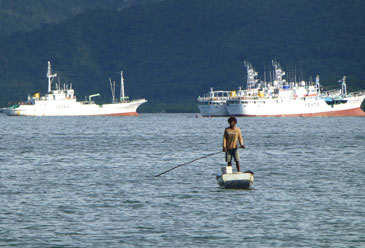The future management of one of the world’s most significant fisheries which spans more than 30 million square kilometres of the Pacific Ocean will be under review at back-to-back forums over the next week at the headquarters of the Secretariat of the Pacific Community (SPC) in Noumea, New Caledonia.
Marine scientists, natural resource managers, researchers, community fishers and non-governmental organisations from 24 countries and territories will take part in a forum on the future of Pacific coastal and inshore fisheries management from today until Thursday.
It will focus on the role of communities in coastal fisheries and natural resource management, and how community-level action can contribute to national systems addressing future food security and livelihoods.
The catch from Pacific coastal fisheries alone is estimated at 155,000 tonnes per year with a value of US$320-500 million.
Across the region, small-scale fisheries provide vital income for around 50% of coastal households and also comprise 50–90% of dietary protein.
Regional food security is a crucial issue linked to fisheries, with per capita seafood consumption in many Pacific Island countries and territories three to five times higher than the global average, for example ranging from 18kg per person per year in Papua New Guinea to 147kg per person per year in Tuvalu.
The forum is being staged by SPC in partnership with the Australian Department of Foreign Affairs and Trade, the Australian Centre for International Agricultural Research, World Fish, the University of Wollongong and the Locally-Managed Marine Area Network.
It will be followed by the 9th biennial Heads of Fisheries meeting from 6-12 March at which senior Pacific government officials, Pacific regional agencies and observers will convene to examine SPC’s fisheries and aquaculture work and its linkages to national and territorial fisheries administrations, and issues facing the region’s coastal and oceanic fisheries.
SPC has a major role in scientific assessments of the status of both regional tuna stocks – for what is the world’s biggest tuna fishery – and of the coastal fisheries of individual Pacific Island countries and territories.
As the major Pacific fisheries meeting for 2015, the gathering will also examine: stock assessments; the need for standardised data collection for coastal fisheries and aquaculture; SPC scientific research on tuna and other species; the potential of deep-water snapper; and a long-term strategy for training fisheries observers.
European Union (EU) support for fisheries in the Pacific will also be discussed, with a review of the achievements and lessons learned from the concluding EU-funded SciCOFish Project, and consideration of a potential new EU fisheries partnership for the region.
“Fisheries, as a key issue for food security, livelihoods and economic growth, need long-term planning and considerable coordination among agencies, regional NGOs, donors, community organisations and other stakeholders and sectors,” the Director of SPC’s Fisheries, Aquaculture and Marine Ecosystems Division, Moses Amos, said.
“With coastal fisheries, the results of good management, or lack of it, have long-term impacts at the national level, while for highly migratory oceanic fisheries resources like tuna, fisheries management in one country’s waters has impacts that can be felt within the region and beyond,” Mr Amos said.




